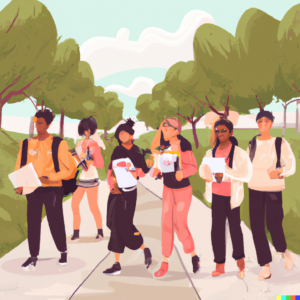Top 10 Stories in Education in 2011
“Top 10 Stories in Education in 2011” by Meredith Ely was originally published on the Learn Boost blog.

As 2011 comes to a close, the time has come to reflect on how innovation and perhaps failure have shaken up the education system. A version of this post was originally published on the LearnBoost blog (that I manage), but it has been syndicated for its broader implications and interest to a more general audience. As the head of nontechnical operations at LearnBoost, I have the pleasure of parsing through education news, blogs, policy, Tweets, conversations, and events, and any other happenings that affect students. Since I left the classroom last summer and jumped into the world of education technology in Silicon Valley, facets of education have evolved in huge ways and digressed in others.
After reflecting on the ed-tech space over the last year, I have aggregated the top 10 stories in education (technology). Where the pieces settle will be largely up to the oncoming year, but we think the following trends have the potential to hugely change the education landscape.
1. Hacking Education. Strong is the will to break away from the traditional, industrial schooling model and move toward individualized learning enhanced by 21st century technology. This concept, which I loosely call “hacking education,” is a movement that is not confined to 2011, but has gained steam as educators, entrepreneurs, journalists and technologists connect. Sir Ken Robinson’s famous animated articulation continues to ground the discussion, but all around the world, local innovators are springing up to perpetuate real change in great knowledge exchanges. From LearnBoost’s Edu Tech Innovators Meetups in San Francisco and Colorado (and more in the works!) to edu-focused TEDx events to savvy publications like EdSurge, the urge to meet up, collaborate, and change the paradigm is growing, and growing fast. Ideas are becoming action!
2. Open Source. Open source coding communities are not new, but the attention of open source technology in education has gained tremendous steam in the last year. Moodle, Sakai, LearnBoost and Instructure lead the charge as open-source ed-tech companies and products, while Creative Commonslicensing has spearheaded a shift toward open sharing and open publishing on a personal level. Often equated with “free,” open sourcing is actually more nuanced; it allows for broad-scale collaboration and better technology, which often leads to cheaper or free technology. Something to note and explore would be the differences among a) content enabled by open licensing (Creative Commons), b) crowd-sourcing to bring about cheaper tech with quicker iteration, c) various business models that promote free products, and finally d) open-sourcing code upon which applications are built. All very different, each of these is often grouped into “open-source,” but the implications and meanings are quite distinct.
3. Free versions of industry software. When talking about the education market, there’s no avoiding the incumbent players, Pearson and Blackboard, Inc. As more freemium and nimble startups race to the market, an air of broad-sweeping disruption has permeated the space. One of the most interesting products of new competition from small yet powerful companies with more innovative business models is the launch of free suites from the 2 big players. Blackboard’s free version, CourseSites, and Pearson’s OpenClass indicate a bold move from companies that have staked their rule on the edu landscape with expensive offerings. For more in-depth analyses of this trend, check out Michael Feldstein’s “Why Pearson’s OpenClass Is a Big Deal” and Audrey Watters’ write up on CourseSites.
4. Data Portability. A subsidiary trend from the move toward “free” software is the importance of data portability. Expressed by LearnBoost’s CEO, Rafael Corrales, in “Education’s Hidden Ticking Time Bomb”and Jim Shimabukuro, editor of ETC Journal, in “The New ‘Open’ Is Closed” — Microsoft and Google Still Don’t Get It,” the definition of “free” is getting a second look. As Rafael put it, “If you aren’t paying with dollars for a service, then you’re paying with your data.”
5. Flipping the classroom. During the ISTE conference in Philadelphia this year, between sessions and seminars, the halls were abuzz with chatter about “flipped classrooms.” Teachers all over the world are finding unique advantages to flipping the traditional lecture-homework concept on its head. The general gist is that students utilize home time for learning principles, then class time is freed for personalized interactions with the teacher. Take, for instance, Khan Academy‘s wild success this year, where in this case, the teacher is more of a facilitator to ensure that each child masters concepts learned via online lessons.
6. Talent + Money + Innovation. Last year a plethora of education companies emerged from a curious mix of bootstrapped couch-surfing to AngelList direct investments to full-blown venture capital raises. A steady theme of 2011 is the bigger price tags on formal investments as well as the increasingly dedicated education VCs — think of 2tor‘s $30+ million, Inkling‘s $17 million, or Inigral’s unprecedented $2 millionfrom the Bill and Melinda Gates Foundation this year. The entreprenuerial space, replete with incubators, Startup Weekends, funds, mentors, and high profile partnerships is now supporting a vast educational arm. It appears as though the intersection of money and talent is increasing in education. Incubators likeImagine K12 and Startl are ramping up the skills and talent needed to bring real innovation to the education space. Intensive events like Startup Weekend EDU and Education Hack Day are bringing the techie awareness to the edu space. Education-specific funds like NewSchools Venture Fund are meeting mainstream funders like Atlas Ventures and Greylock Partners, proving the value in the edu market by paying forward hefty investments for new projects.
7. Google vs. Apple vs. Amazon. The 1:1 student to tech device ratio has been picking up inertia, but this year we welcomed Google’s Chromebook and the Amazon Kindle Fire to the mix along with longstanding champ, Apple’s iPad into the realm of education. Schools are still working out the best ways to “go digital,”but the hardware seems to be catching up to the abundance of software, and that is great news for the entire ecosystem.
8. Personal Learning Networks. When we wrote the top 10 list of 2010, we noted “Entrepreneurship and New Media” as a largely new concept in education. The idea of integrating social media in educational practice has evolved in the last year. The clamor for “social media” has hushed as people shift their use of online tools and communities under the umbrella of the “personal learning network” or PLN. Sure, the differences between social media and PLNs are only as complex as you want them to be, but I’d like to highlight one way in which the change to “PLN” affects the way we view social media in the school environment. Like in Ryan Tyler’s write-up on Google+ in the classroom, you can see that the concept of surrounding oneself with amazing knowledge sources is different, and in ways more robust, than merely engaging socially. Online communities were making their ways into classrooms before, but there is a new perspective on how to better leverage and segment these resources for learning, development, engagement, and sharing as opposed to just staying in touch.
9. Gamification. The focus on game mechanics in education has gone from a trickle to a deluge this year as more and more developers, entrepreneurs, and teachers search for ways to harness the power of gamification in the classroom. From actually using video games to engage students to digitizing incentiveswith “badges,” drawing the fun and iterative principles of gaming to education has vendors, teachers, students, and parents drooling over the possibilities. The hype is warranted when talented, educated teachers like Alice Keeler are at the helm, but with poorly constructed pedagogy, there are at least three reasons not to gamify education.
10. Schema.org In June, The Association of Educational Publishers and Creative Commons announced the collaborative effort on a learning resources framework initiative. Just after the launch of Shema.org, a universal framework for tagging online content to help major search vendors (Google, Yahoo! and Bing) index everything from text to multimedia web-based materials. Essentially, the metadata collected would help educators and learners quickly and efficiently find relevant educational material online. As a precaution, tech journalist Audrey Watters notes that what is educational is not always what’s optimized for SEO. As the Internet plays a bigger part in content delivery (be it in flipped or traditional classrooms), metadata undoubtedly will continue to creep its way to education companies’ agendas. Ultimately, we hope that tagging schemes provide teachers with easy ways to find rich content and not just a way for large incumbent vendors to strangle out smaller companies. The web has a way of pushing people to iterate toward openness, so we’re hopeful on this front as well.
Last year I touched on a broader range of specific political and social events that triggered changes in the education space. This time around, I tended toward movements and themes in the education technology arena. That is not to say that there have not been immensely influential happenings in funding and legislation that affected schools. Notable are amendments to No Child Left Behind, more rounds of Investing in Innovation (i3), analyses of Finland’s education system and the reintroduction of the DREAM Act. Schools run into challenges and opportunities daily that completely change the trajectory for their students, so please share if you think something else should be on this list.







0 Comments
Leave a Comment
Your email address will not be published. All fields are required.